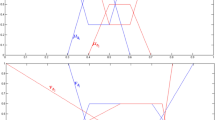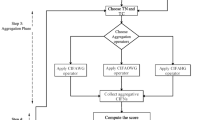Abstract
Orthopair fuzzy sets (OFSs) generally include q-rung orthopair fuzzy sets (q-ROFSs) and symmetrical linear orthopair fuzzy sets (SLOFSs), and the latter two models have a common element: intuitionistic fuzzy sets (IFSs). T-norms, t-conorms, and multiple-criteria decision-making (MCDM) are applied to q-ROFSs, but they have not been applied to SLOFSs. These valuable parts of SLOFSs are investigated by extending and simulating relevant results in IFSs, and their operational connections to addition and scalar multiplication are addressed in detail. For SLOFSs, axiomatic definitions, general properties, and concrete constructions for t-norms and t-conorms are first given. Then, special types of t-norms and t-conorms are used to motivate the addition and scalar multiplication operations, and related properties of the operations are obtained. Finally, addition and scalar multiplication are linearly combined with aggregation, and a relevant technique for order preference by similarity to an ideal solution (TOPSIS) method is designed for decision cognition. In this way, a new MCDM method based on SLOFSs is established, and its high reliability is validated by comparing the corresponding method based on q-ROFSs in two practical examples. This study advances work on SLOFSs and linearly extends IFS results, thus enriching OFSs, especially for cognitive computations and applications.



Similar content being viewed by others
Explore related subjects
Discover the latest articles and news from researchers in related subjects, suggested using machine learning.Data Availability
Data sharing is not applicable to this article as no datasets were generated or analyzed during the current study.
References
Zadeh LA. Fuzzy sets. Inf Control. 1965;8(3):338–53.
Ciucci D. Orthopairs and granular computing Granul Comput. 2016;1:159–70.
Yager RR. Generalized orthopair fuzzy sets. IEEE Trans Fuzzy Syst. 2017;25(5):1222–30.
Gao S, Zhang XY. Linear orthopair fuzzy sets. Int J Fuzzy Syst. 2022;24:1814–38.
Li ZS, Chang KH. A novel Pythagorean fuzzy set-based risk-ranking method for handling human cognitive information in risk-assessment problems. Syst. 2023;11(8):402.
Xin XW, Shi CL, Sun JB, Xue ZA, Song JH, Peng WM.A novel attribute reduction method based on intuitionistic fuzzy three-way cognitive clustering. Appl Intell. 2023;53(2):1744–1758.
Atanassov KT. On intuitionistic fuzzy sets theory. Heidelberg: Springer; 2012.
Xu ZS. Intuitionistic fuzzy aggregation operators. IEEE Trans Fuzzy Syst. 2007;15(6):1179–87.
Yager RR, Abbasov AM. Pythagorean membership grades, complex Numbers, and decision making. Int J Intell Syst. 2013;28(5):436–52.
Yager RR. Pythagorean membership grades in multicriteria decision making. IEEE Trans Fuzzy Syst. 2014;22(4):958–65.
Senapati T, Yager RR. Fermatean fuzzy sets. J Ambient Intell Humaniz Comput. 2020;11:663–74.
Garg H, Rani D. Generalized geometric aggregation operators based on t-norm operations for complex intuitionistic fuzzy sets and their application to decision-making. Cogn Comput. 2020;12:679–98.
Bartoszuk M, Gagolewski M. T-norms or t-conorms? How to aggregate similarity degrees for plagiarism detection. Knowl-Based Syst. 2021;231: 107427.
Klement EP, Mesiar R, Pap E. Triangular norms. Dordrecht, The Netherlands: Kluwer; 2000.
El-Zekey M. Lattice-based sum of t-norms on bounded lattices. Fuzzy Sets Syst. 2020;386:60–76.
Chang Q, Zhou HJ. Distributivity of N-ordinal sum fuzzy implications over t-norms and t-conorms. Int J Approx Reason. 2021;131:189–213.
Dan Y, Hu BQ, Qiao J. New construction of t-norms and t-conorms on bounded lattices. Fuzzy Sets Syst. 2020;395:40–70.
Rahman K. Some new logarithmic aggregation operators and their application to group decision making problem based on t-norm and t-conorm. Soft Comput. 2022;26:2751–72.
Dvor̆ák A, Holc̆apek M.New construction of an ordinal sum of t-norms and t-conorms on bounded lattices. Inf Sci. 2020;515:116–131.
Zhou H. Characterizations of fuzzy implications generated by continuous multiplicative generators of T-norms. IEEE Trans Fuzzy Syst. 2021;29(10):2988–3002.
Lu J, Zhao J. Distributivity of a class of ordinal sum implications over t-norms and t-conorms. Fuzzy Sets Syst. 2020;378:103–24.
Deschrijver G, Cornelis C, Kerre EE. On the representation of intuitionistic fuzzy t-norms and t-conorms. IEEE Trans Fuzzy Syst. 2004;12(1):45–61.
Lei Q, Xu ZS, Bustince H, Fernande J. Intuitionistic fuzzy integrals based on Archimedean t-conorms and t-norms. Inf Sci. 2016;327(10):57–70.
Yang Y, Chin KS, Ding H, Lv HX, Li YL. Pythagorean fuzzy Bonferroni means based on T-norm and its dual T-conorm. Int J Intell Syst. 2019;34(6):1303–36.
Hadi A, Khan W, Khan A. A novel approach to MADM problems using Fermatean fuzzy Hamacher aggregation operators. Int J Intell Syst. 2021;36(6):3464–99.
Darko AP, Liang DC. Some q-rung orthopair fuzzy Hamacher aggregation operators and their application to multiple attribute group decision making with modified EDAS method. Eng Appl Artif Intel. 2020;87:103259.
Luo X, Xu ZS, Gou XJ. Exponential operational laws and new aggregation operators of intuitionistic Fuzzy information based on Archimedean T-conorm and T-norm. Int J Mach Learn Cyb. 2018;9:1261–9.
Garg H. Generalized Pythagorean fuzzy geometric aggregation operators using Einstein t-corm and t-conorm for multicriteria decision-making Process. Int J Intell Syst. 2017;32(6):597–630.
Dick S, Yager RR, Yazdanbakhsh O. On Pythagorean and complex fuzzy set operations. IEEE Trans Fuzzy Syst. 2016;24(5):1009–21.
Wei GW, Lu M. Pythagorean fuzzy power aggregation operators in multiple attribute decision making. Int J Intell Syst. 2018;33:169–86.
Liu P, Wang P. Some q-rung orthopair fuzzy aggregation operators and their applications to multiple-attribute decision making. Int J Intell Syst. 2018;33(2):259–80.
Yahya M, Abdullah S, Chinram R, Al-Otaibi YD, Naeem M. Frank aggregation operators and their application to probabilistic hesitant fuzzy multiple attribute decision-making. Int J Fuzzy Syst. 2021;23(1):194–215.
Sarkar B, Biswas A. Linguistic Einstein aggregation operator-based TOPSIS for multicriteria group decision making in linguistic Pythagorean fuzzy environment. Int J Fuzzy Syst. 2021;36(6):2825–64.
Liu PD, Chen SM, Liu JL. Multiple attribute group decision making based on intuitionistic fuzzy interaction partitioned Bonferroni mean operators. Inf Sci. 2017;411:98–121.
Rawat SS, Komal. Multiple attribute decision making based on q-rung orthopair fuzzy Hamacher Muirhead mean operators. Soft Comput. 2022;26(5):2465–2487.
Wang J, Wei GW, Wei C, Wu J. Maximizing deviation method for multiple attribute decision making under q-rung orthopair fuzzy environment. Def Technol. 2022;16:1073–87.
Yang W, Pang YF. New q-rung orthopair fuzzy partitioned Bonferroni mean operators and their application in multiple attribute decision making. Int J Fuzzy Syst. 2019;34(3):439–76.
Shen F, Ma XS, Li ZY, Xu ZS, Cai DL. An extended intuitionistic fuzzy TOPSIS method based on a new distance measure with an application to credit risk evaluation. Inf Sci. 2017;428:105–19.
Zhang XL, Xu ZS. Extension of TOPSIS to multiple criteria decision making with Pythagorean fuzzy sets. Int J Fuzzy Syst. 2014;29:1061–78.
Liang DC, Xu ZS, Liu D, Wu Y. Method for three-way decisions using ideal TOPSIS solutions at Pythagorean fuzzy information. Inf Sci. 2018;435:282–95.
Alkan N, Kahraman C. Evaluation of government strategies against COVID-19 pandemic using q-rung orthopair fuzzy TOPSIS method. Appl Soft Comput. 2021;110: 107653..
Mahmood T, Ali Z. Entropy measure and TOPSIS method based on correlation coefficient using complex q-rung orthopair fuzzy information and its application to multi-attribute decision making. Soft Comput. 2021;25(2):1249–75.
Zhang XY, Chen BW, Miao DQ. Systematic feature selection based on three-level improvements of fuzzy dominance three-way neighborhood rough sets. IEEE Trans Fuzzy Syst. 2024;32:5060–72.
Funding
The work was supported by Natural Science Foundation of Sichuan Province of China (2024NSFSC0486), Sichuan Science and Technology Program of China (2022ZYD0001), Humanities and Social Sciences Project of the Ministry of Education of China (23YJA630114), and Taiyuan Institute of Technology Scientific Research Initial Funding (2023KJ054).
Author information
Authors and Affiliations
Corresponding author
Ethics declarations
Ethical Approval
This article does not contain any studies with human participants or animals performed by any of the authors.
Conflict of Interest
The authors declare no competing interests.
Additional information
Publisher's Note
Springer Nature remains neutral with regard to jurisdictional claims in published maps and institutional affiliations.
Appendix. Theorem 4’s proof regarding the second case (i.e., SLOFSs (2))
Appendix. Theorem 4’s proof regarding the second case (i.e., SLOFSs (2))
Proof
For SLOFSs (2), we mainly adopt Tables 27, 28, 29, 30 for T-operation verification. At first, we prove T is a mapping on \((L^{**})^2\rightarrow L^{**}\). If \(\alpha _{1},\alpha _{2}\in D_{3}\), then \(0<\frac{\omega }{2\omega -1}(\mu _{i}-\frac{1-\omega }{\omega })\le 1, 0<\frac{\omega }{2\omega -1}(\nu _{i}-\frac{1-\omega }{\omega })\le 1\) (\(i=1,2\)), and we have
Due to the strong dual pair (t, s) and Theorem 3 (3)’s proof, we have
So,
and
Hence, \(T(\alpha _{1},\alpha _{2})\in D_{3}\) becomes a SLOFN. Other distributions regarding \(\alpha _{1},\alpha _{2}\) have similar checks, and relevant results are provided in Table 27. In other words, T submits to the operation closure for range \(L^{**}\).
Then, for operation T, its (T1) commutativity is directly obtained by defined formulas. When \(\alpha _{1}\in D_1\), its (T2) associativity, (T3) monotonicity, and (SLOFT4) border can be proved from Tables 28, 29, and 30, respectively. Other cases, such as \(\alpha _{1}\in D_2, D_3, D_4\), can be discussed similarly.
Therefore, T is a SLOF t-norm. Similarly, S is a SLOF t-conorm. \(\square \)
Rights and permissions
Springer Nature or its licensor (e.g. a society or other partner) holds exclusive rights to this article under a publishing agreement with the author(s) or other rightsholder(s); author self-archiving of the accepted manuscript version of this article is solely governed by the terms of such publishing agreement and applicable law.
About this article
Cite this article
Gao, S., Zhang, X. & Mo, Z. T-Norms and T-Conorms of Symmetrical Linear Orthopair Fuzzy Sets and Their Cognitive Applications in Multiple-Criteria Decision-Making. Cogn Comput 17, 82 (2025). https://doi.org/10.1007/s12559-025-10439-9
Received:
Accepted:
Published:
DOI: https://doi.org/10.1007/s12559-025-10439-9




